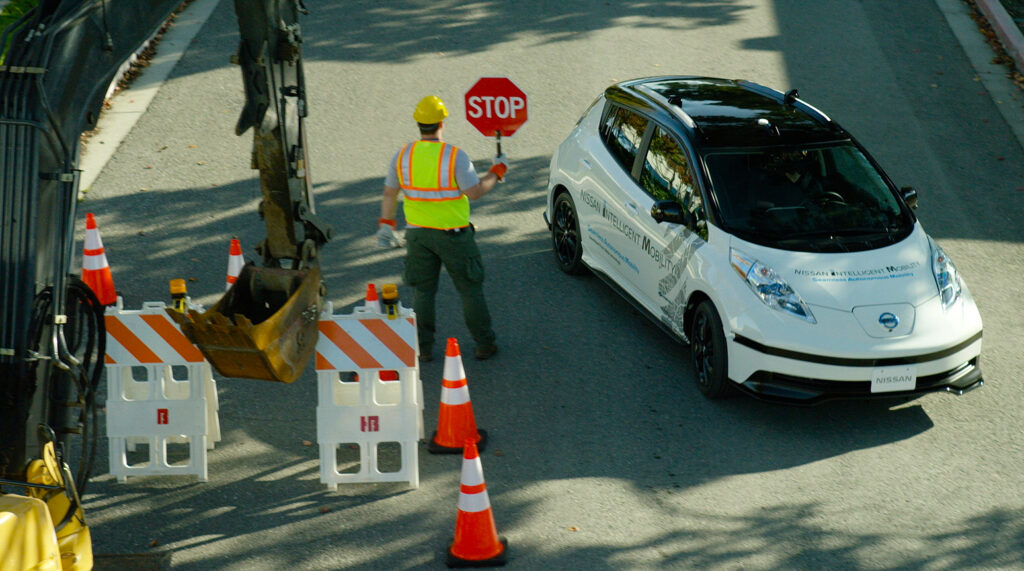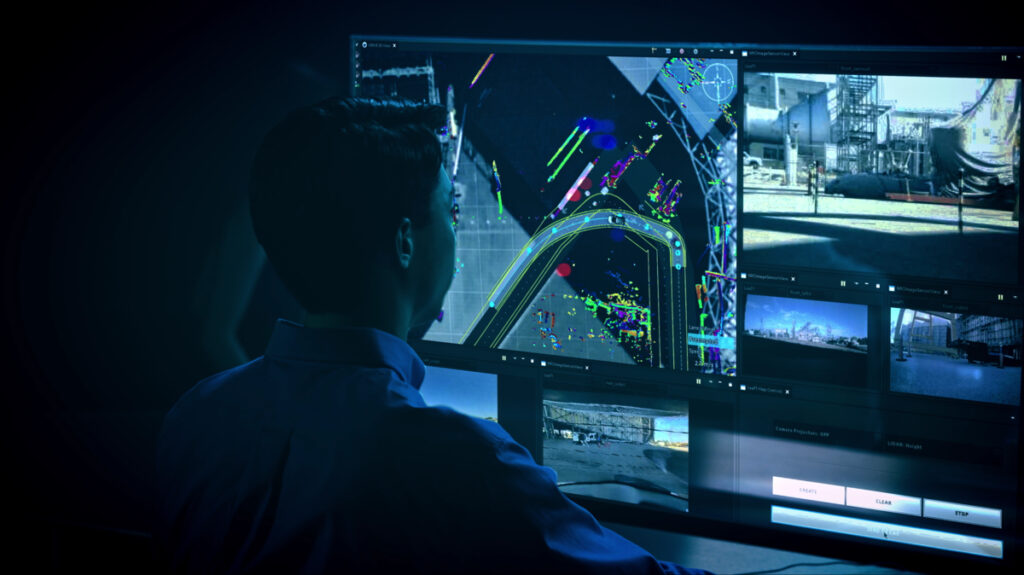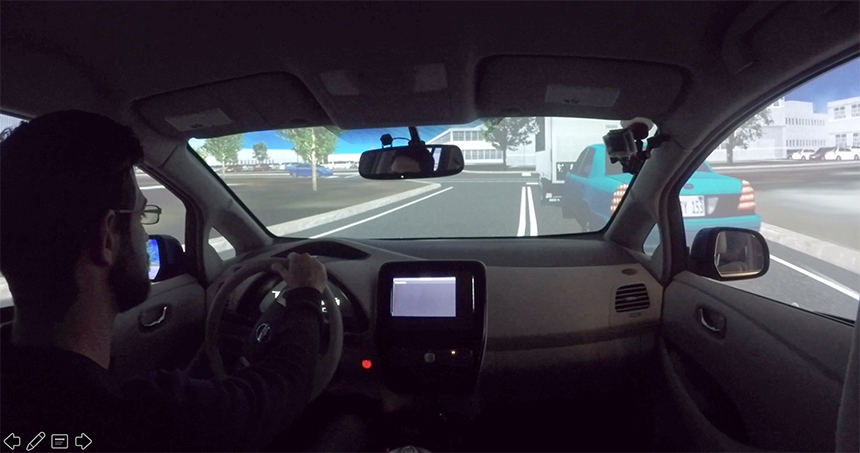As researchers working on automated vehicles, we are grappling with fundamental questions about how to do research and design for the future. Or, to be more precise, how can we tap into and participate in futures that are in the process of being made, that may both reproduce and rearrange experiences of today?
One of the questions we must ask is, what is autonomy to begin with? In the era of the rise of increasingly self-acting machines, what exactly will these machines be autonomous from? How are people grappling with shifting perceptions and experiences of autonomy? Our research has explored how people confront ideas about what the future may hold and, more profoundly, how reconfigurations of socio-technical systems today confront them in their own notions of autonomy.
Our paper about one of our research projects on this topic was accepted for EPIC2017, but not without some interesting debate. Anonymous peer reviewers raised a question about whether the work we reported on was ethnographic at all. The primary data for our paper was taken from interviews with people who had engaged in a staged experiment in a simulator. Isn’t this the very anti-thesis of ethnography? What could be further from a methodology dedicated to understanding people in their own, everyday environments?
One possible scenario for the future of self-driving cars is that remote supervision will play a crucial role. In other words, the vehicle operates autonomously vis-à-vis the passenger, but under the continuous surveillance of remote actors who could, if necessary, intervene. Our study aimed to explore people’s responses to this remote supervision when they are passengers of an autonomous vehicle. How would they make sense of this remote human-in-the-loop person and what interaction might they expect to have with them, if any?
This work opened up to us a rich exploration of how people thought about their own autonomy, the autonomy of other humans, and what it might mean to engage not only with the ‘autonomous’ system of the vehicle (the AI under the hood, so to speak), but also the human-infused, disembodied AI-in-the-cloud. We formulated this study essentially as an ethnographic encounter—an ethnographic encounter staged through speculative futures.
What does it mean to do ethnography of the future? How can we claim that research involving a staged experience constitutes ethnography at all? We argue for speculative ethnography by questioning the distinction between the real and the speculative, as well as suggesting that the issues we face in a high-tech Silicon Valley research lab aren’t actually so different from those ethnographers around the world have always grappled with.
Grappling with Autonomy
by ERIK
I am a physicist, an English lit major, a media scholar, and now a graduate student in Science and Technology Studies. I like to say I am “becoming an anthropologist” because of the significant value of ethnographic tools, but I’m not any more dogmatically committed to ethnography than I am to controlled experiments or grounded philosophical theories. But both Melissa and I felt we had a lot to say to the EPIC community and its ongoing engagement with the concepts and products of technology businesses, particularly given EPIC2017 theme Perspectives that actively seeks out diverse vantage points and interlocutors. I also felt, especially as a new entrant to the space, I needed to make a case for why what we were doing matters to ethnographic praxis.
Our core argument about speculative ethnography is as follows: Adding autonomy to vehicles presents a moment in which we must ask how the rest of driving practice, cultural and psychological, will respond. The question is, how can this be investigated empirically? These changes are still speculative ones, the systems on which this restructuring depends are still in development. Ostensibly, the usual methods of ethnographic participant observation fail: there is nothing “out-there” to participant-observe. Users do not normally interact with nonexistent objects, and there are no existing, uncontrived and uncontrolled practices to examine.
Current vehicle automation technologies (such as those on the market in ADAS systems) are still too partial to do more than hint at the kind of practice changes that interest us. And interacting with automobile systems is different from interacting with trains or aircraft, so these too are only partial matches for what we may see in the future.
Yet, design anthropology (and other fields) has critiqued the doctrine that what we are studying is in fact “out there” (Venkataramani and Avery 2012; Nafus and Anderson 2006). Investigating the “real” is a not sufficient description of what we are actually doing when we do ethnography, nor is it the only plausible means of knowledge production for an engaged anthropology. So, in the spirit of anticipatory or speculative ethnography (Lindley, Sharma, and Potts 2015; Halse and Clarke 2008; Smith et al 2016), we made our own microworld in which to observe.
Within that simulated microworld, we could provide participants a glimpse of new types of experiences that they could not otherwise engage with. Yes, that microworld was produced with the help of the gutted shell of a Nissan Leaf, a bunch of screens and projectors, some hydraulic actuators, and a lot of software. But, in the space in which we work, none of this is clearly “less” real than other options—it is differently real. Even if we could have run the car on the street, that wouldn’t be fully real: code is in development and road users don’t really have a practice for encounters with autonomous vehicles. The roadway now does not look nor work like it may in the years to come. There is nothing that can be held fixed as the reference point for what the “real” future is like. We wished to shed light on possible futures, and chose in this particular case to use simulation as a lens.
To be sure, both simulation and controlled experiments raise a plethora of issues. They are too partial and cannot account for things beyond their frame. Simulation cannot be the whole answer because it is too far removed from everyday practice. But it can be a part of that answer, especially when considered as a space for the cultivation of new types of experiences. And that’s our key point: design interventions can be a means to explore and elicit reactions to experiences that are in their formative stages. Some even argue that all experiences are always already emergent (see, for instance, Otto and Smith 2013; Rabinow et al., 2008; Smith and Otto 2016. For a recent and more popular and psychological take, see Seligman and Tierney in the New York Times).
As part of setting up this investigation in this way, we appear to have accepted the argument that machinic “autonomy” doesn’t yet exist, and thus requires speculation in order to be investigated. But this assumption risks also accepting the very distinction between autonomy and non-autonomy we mean to challenge. Indeed, in my work at large I have long been haunted by the vexed partiality of autonomies. My master’s thesis is an extended dialogue about what “autonomy” really means in which I argue that binary configurations of autonomy are a fantasy, a categorical misunderstanding. So positing that autonomy exists only speculatively buys into the paradigm that existence or non-existence is the only relevant measure.
The appropriate question is not whether vehicles are autonomous—this statement has very little technical meaning. The question is how and where and when and why they exhibit autonomous properties. There indeed could be massive reconfigurations coming—cars without steering wheels and brake pedals, or vehicles that drive like normal cars until they detect a crash and then act to avoid it, or systems that are always human-machine co-operative vehicles, where agency for movement is negotiated moment-by-moment via haptic shared control. What I think needs to be understood, however, is that such changes, if they occur, are not uni-directional. “More autonomy” is not necessarily better. Technically, autonomy is a mirage because all systems, when seen through a wide lens, are hybrid human-machine systems. But our EPIC2017 paper makes the argument that the technical validity of “autonomy” is really beside the point; what people mean when they say “this car is autonomous” may really be more like “this car makes me more autonomous” in certain ways. And yet it may impinge upon human autonomy in others. The balance of different kinds of autonomy has impact on how this new kind of driving is experienced.
What we believe is that a speculative mode was the only way we could make these dynamics “real” to participants, in an experiential way. And that is what, with our hybrid ethnographic-user-study-experiment formulation, we attempted to do using simulation.
Grappling with Ethnography
by MELISSA
As we worked through drafts of our submission to EPIC, I found myself struggling with our need to defend this work as “ethnographic”. This was indeed a controlled experiment in a simulated environment; people engaged in an artifice we’d constructed. And I’m right up there with the next ethnographer in worrying that facile appropriations of any interaction with a “real” person as ethnographic devalue ethnography. But here we need to be careful. Should ethnography be centrally defined by the action of being in the “real” world and talking with people? Should ethnographers be centrally preoccupied with policing the definition of the “real” world where those conversations are taking place?
I believe not. Rather, our concern is the framing and intent of our engagements with people. It is the nature of the understanding being sought in the exploration—and only derivatively, therefore, on the sites and occasions of those observations and encounters. In a haste to defend our methodology, we nearly missed this core point. Our controlled experiment did indeed produce ethnographic data.
How ironic that I, with decades of experience in applied ethnographic research and an identity largely enmeshed with the world of industrial ethnographic research, would be challenging Erik, an STS scholar without the slightest hint of ethnographic fundamentalism, to simply accept rather than defend the data as ethnographic! A few thoughts are in order.
First, the paper we are writing for EPIC2017 poses the question of how to empirically investigate experiences that have yet to exist. The fact of the non-existence of autonomous vehicles, and especially of the remote supervisory capability (Seamless Autonomous Mobility), is posited as a “barrier” to the ability to study how people might think about and engage with autonomous vehicle systems ethnographically. But for what kinds of questions is that a problem, really? For what form of research?
If our aims were to assert what people would actually do in the future, this could be a problem. But weren’t we instead exploring what notions of autonomy mean to people? Was this not a means, given that socio-material worlds always already frame people’s experiences and understandings, to explore how people live in, respond to, and make meaning from their socio-material worlds today? We are not in the business of predicting the future, but we are trying to engage people in ways that render new consideration of their lives as they look ahead. A good interview often does the same.
Second, one of the hallmarks of ethnography is its concern for the everyday. And here I must concede, the experience we staged for folks was anything but the everyday!
Or was it? In fact, not necessarily. Never mind that the situations people faced in the simulator were situations that people face every day: driving, mentally planning for the next thing on the schedule, navigating road construction, deciphering an obstacle on the road. A little cartoonish, yes. But futuristic? Not really. Particularly in Silicon Valley, where devising, developing, testing, and selling new ideas is all too often a quotidian experience for local inhabitants. People encounter promises of new technologies, new experiences, new possibilities at every turn, at the coffee shop, in billboards, at work, in the changing landscape of company names on buildings. Another day, another innovation. Plus ca change, plus c’est la meme chose.
In fact, would the proverbial village ethnographer of yore have avoided taking note of local people’s reactions to newly arriving objects, to technologies she herself brought to the field? Simulation is a mainstay of work in these fields. Wouldn’t we be enforcing an odd kind of essentializing to deny inclusion of people’s experiences with these objects into our consideration?
Indeed, we needn’t default to the exceptionalism of Silicon Valley to ponder the everydayness of encounters with the speculative. One of the things that scholars at the intersection of design, anthropology and futures have done so richly is engage the essential, prospectivist orientation of human kind. Yes we live in the everyday. Yes we engage history and spin intricate webs of culture. But we do so with an eye toward what’s next. Foresight, anticipation, engagement are all about the already becoming.
One final thought. Anthropologists have long studied people’s relations to unseen, differently construed, ‘imagined’, worlds. Ethnographic studies have always been, in some form, a means of engaging not only with what ‘is’, with what has material form (though it indeed excels at that!), but also with what is sought and what is desired. If ever there was a modality of research that respectfully engages with worlds that can’t be explained by a flat-footed spectrum of reality, ethnography is it!
Our simulated autonomous vehicle study itself was not “an ethnography”, any more than the singular dips into the field we so often hear about as part of product development and marketing (which do, alas, often go under that rubric) are. But the engagement does add to our growing ethnographic understanding of road use and driving practices as we encounter increasingly automated machines in our lives. We have the luxury of an extended inquiry. Let’s meet people where they are on that journey.
Nissan is an EPIC2017 Sponsor.
References
Photos 1 & 2: Images from Nissan “Seamless Autonomous Mobility” (SAM) Newsroom. To accelerate the time it will take for autonomous vehicles to get on the road safely, at CES 2017 Carlos Ghosn announced a breakthrough technology called “Seamless Autonomous Mobility,” or SAM. Developed from NASA technology, SAM partners in-vehicle artificial intelligence (AI) with human support to help autonomous vehicles make decisions in unpredictable situations and build the knowledge of in-vehicle AI. This technology could potentially enable millions of driverless cars to co-exist with human drivers in an accelerated timeline. It is part of Nissan Intelligent Integration.
Photo 3: Research participant in the simulator, courtesy of the authors.
Halse, Joachin and Brendon Clark
2008 Design Rituals and Performative Ethnography. Ethnographic Praxis in Industry Conference Proceedings 2008: 128-145.
Lindley, Joseph, Dhruv Sharma, and Robert Potts
2015 Operationalizing Design Fiction with Anticipatory Ethnography. Ethnographic Praxis in Industry Conference Proceedings 2015: 58-71.
Nafus, Dawn and Ken Anderson
2006 The Real Problem: Rhetorics of Knowing in Corporate Ethnographic Research. Ethnographic Praxis in Industry Conference Proceedings 2006: 244-258.
Otto, Ton and Rachel Charlotte Smith
2013 “Design Anthropology: A Distinct Style of Knowing”, in Wendy Gunn, Ton Otto, and Rachel Charlotte Smith (eds), Design Anthropology: Theory and Practice, London and New York: Bloomsbury.
Rabinow, Paul, George Marcus, Jim Faubian, and Tobin Rees
2008 Designs for an Anthropology of the Contemporary, Durham, NC; Duke University Press.
Seligman, Martin E.P. and John Tierney
2017 “We Aren’t Built to Live in the Moment”. New York Times. May 19.
Smith, Rachel Charlotte and Ton Otto
2016 “Cultures of the Future: Emergence and Intervention in Design Anthropology.” In Design Anthropological Futures, London and New York, Bloomsbury
Stayton, Erik
2015 Driverless Dreams: Technological Narratives and the Shape of the Automated Car. MIT SM Thesis.
Venkataramani, Arvind and Christopher Avery
2012 Framed by Experience: From User Experience to Strategic Incitement. Ethnographic Praxis in Industry Conference Proceedings 2012: 278-295.
 Melissa Cefkin is Principal Researcher and Senior Manager of the Human Centered Systems group at the Nissan Research Center in Silicon Valley. She has had a long career as an anthropologist in industry, including time at the Institute for Research on Learning, Sapient, and IBM Research. Melissa has served as president and conference co-chair of EPIC.
Melissa Cefkin is Principal Researcher and Senior Manager of the Human Centered Systems group at the Nissan Research Center in Silicon Valley. She has had a long career as an anthropologist in industry, including time at the Institute for Research on Learning, Sapient, and IBM Research. Melissa has served as president and conference co-chair of EPIC.
 Erik Stayton is a PhD student in the Program in History, Anthropology, and Science, Technology and Society at MIT. He investigates human interactions with AI systems, and currently studies the values implicated in the design, regulation, and use of automated vehicle systems. He also interns at the Nissan Research Center.
Erik Stayton is a PhD student in the Program in History, Anthropology, and Science, Technology and Society at MIT. He investigates human interactions with AI systems, and currently studies the values implicated in the design, regulation, and use of automated vehicle systems. He also interns at the Nissan Research Center.
Related
Developing Socially Acceptable Autonomous Vehicles, Erik Vinkhuyzen & Melissa Cefkin
Operationalizing Design Fiction with Anticipatory Ethnography, Joseph Lindley et al.
Tutorial: Speculative Design – Futures Prototyping for Research and Strategy, J. Paul Neeley & Elliot Montgomery
The Real Problem: Rhetorics of Knowing in Corporate Ethnographic Research, Dawn Nafus & ken anderson




0 Comments